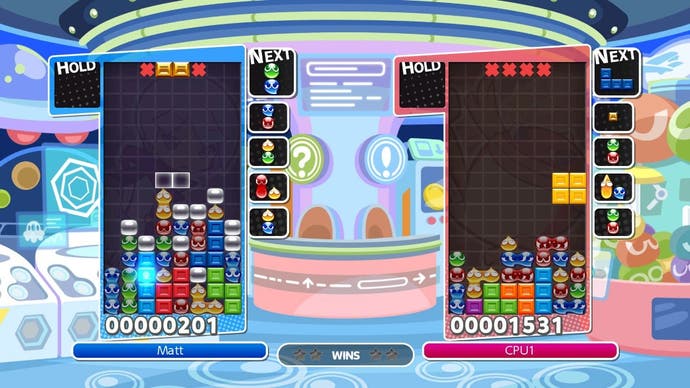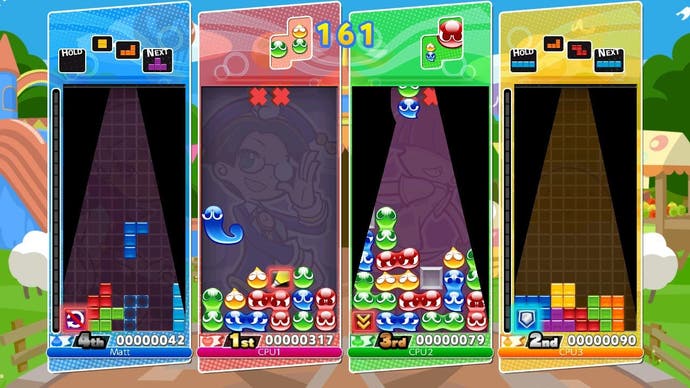The Double-A Team: Puyo Puyo Tetris takes puzzling beyond the infinite
"This mode is not like any other."
The big question around any new handheld is always: what's going to be the new Tetris? For the DS, I'm tempted to say Tetris was Zoo Keeper. For the PSP, Tetris was definitely Lumines, a game that, on a good day, is arguably even better than Tetris in the first place. The Switch? The Switch is such an idiosyncratic console, so strange and yet so familiar. It makes sense, really, that the Switch's Tetris was Tetris.
Kind of. In fact it was Puyo Puyo Tetris, and I don't care what you have to say about Zelda, this cut-price puzzle game, a port of a game first released in 2014, was all you needed for the Switch in the early days. (I appreciate it just missed launch.)
Puyo Puyo Tetris is Tetris and Puyo Puyo. It plays a lovely game of Tetris, with simple readable blocks, lots of colour, and all of the various upgrades like hold and soft- and hard-drops and ghosts. It also plays a lovely game game of Puyo Puyo, the stickiest, sugariest puzzle game of all time in which little blobs of gel fall from the ceiling and must be dealt with.
Listen, though. There is the special harmony of disharmony here. Tetris is sharp and hard-edged, all about shape rather than colour. Puyo Puyo is soft and squishy and as concerned with colour as it is with anything else. You clear Puyo by matching colours, which is very different to clearing Tetriminos by making a line. It's the difference between making a dessert and building a garage. What would ever happen if these two games came together?

Reader, they come together. They come together in Fusion mode. I cannot pretend Fusion mode is my most played part of Puyo Puyo Tetris - in truth I am so committed to Tetris in its purity that I find it hard to pull myself away for long. But Fusion mode still waits there on the select screen and makes me wonder. Something frightening about it really. You know how there's meant to be a supermassive black hole at the centre of the galaxy, and sometimes it's nice to just sit there of an evening and stare at the sky and be gently creeped out by the idea of this huge, largely incomprehensible force of nature roaring away at the middle of everything above our heads? So it's nice to play Tetris, a game I feel I understand, and consider Fusion, a game that is constantly surprising and alarming.
Fusion is something else. It's not just that you sit there while Puyos fall one minute and Tetriminos fall the next like the whole universe is broken. It's not just that these things refuse to actually fuse when they're in the well together - you still have to think about colour with Puyos and lines with Tetriminos. It's that occasionally something weird happens. Okay, not really occasionally. Tetriminos have weight in this world, which means that when they land on Puyos, they sink through them, and then the Puyos rain down again from above.

I wish I could tell you this is the end of it. But in fact it's the start of it. The start of your understanding, the start of the long road to Fusion mastery. Chains! Blocks that shift between Puyo and Tetriminos as they fall! The absolute wild heresy of a couple of new shapes of Tetrimino!
At the end of this is the Smash-Stack, in which you add to a smashing Tetrimino even as it's still moving. Yes. Take a moment to consider that. And at the end of the Smash-Stack is the eight-line clear Smash-Stack. Eight lines.
This is the puzzle game singularity, right here, where time stops and matter is compacted, whole galaxies served up on a teaspoon. Fusion is a game where strange, improbable things can happen. One day, I tell myself, I will master it and understand all of this for myself.

